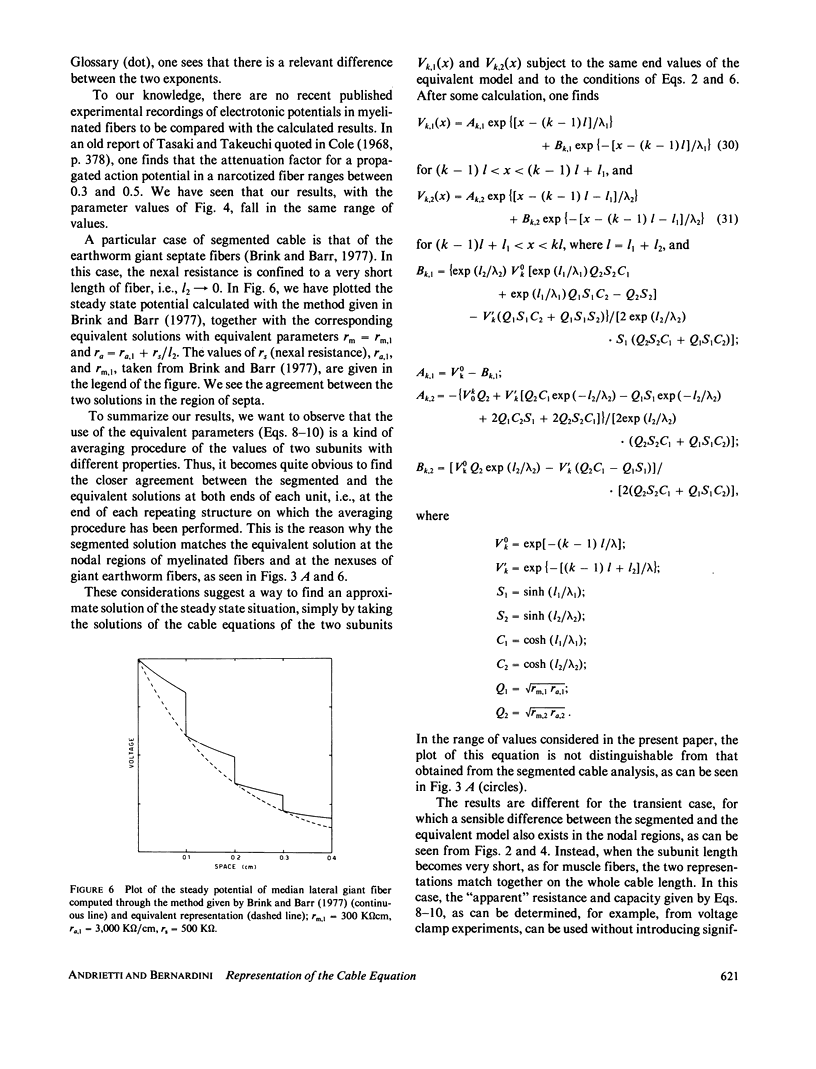Abstract
The linear cable theory has been applied to a modular structure consisting of n repeating units each composed of two subunits with different values of resistance and capacitance. For n going to infinity, i.e., for infinite cables, we have derived analytically the Laplace transform of the solution by making use of a difference method and we have inverted it by means of a numerical procedure. The results have been compared with those obtained by the direct application of the cable equation to a simplified nonmodular model with "equivalent" electrical parameters. The implication of our work in the analysis of the time and space course of the potential of real fibers has been discussed. In particular, we have shown that the simplified ("equivalent") model is a very good representation of the segmented model for the nodal regions of myelinated fibers in a steady situation and in every condition for muscle fibers. An approximate solution for the steady potential of myelinated fibers has been derived for both nodal and internodal regions. The applications of our work to other cases dealing with repeating structures, such as earthworm giant fibers, have been discussed and our results have been compared with other attempts to solve similar problems.
Full text
PDF








Selected References
These references are in PubMed. This may not be the complete list of references from this article.
- Adrian R. H., Chandler W. K., Hodgkin A. L. The kinetics of mechanical activation in frog muscle. J Physiol. 1969 Sep;204(1):207–230. doi: 10.1113/jphysiol.1969.sp008909. [DOI] [PMC free article] [PubMed] [Google Scholar]
- Adrian R. H., Peachey L. D. Reconstruction of the action potential of frog sartorius muscle. J Physiol. 1973 Nov;235(1):103–131. doi: 10.1113/jphysiol.1973.sp010380. [DOI] [PMC free article] [PubMed] [Google Scholar]
- Andrietti F., Bernardini G., Peres A. Analysis of lumped and distributed elements models of cut muscle fibers in vaseline or sucrose gap preparations. Biophys J. 1984 Nov;46(5):625–630. doi: 10.1016/S0006-3495(84)84061-8. [DOI] [PMC free article] [PubMed] [Google Scholar]
- Brink P., Barr L. The resistance of the septum of the median giant axon of the earthworm. J Gen Physiol. 1977 May;69(5):517–536. doi: 10.1085/jgp.69.5.517. [DOI] [PMC free article] [PubMed] [Google Scholar]
- Chiu S. Y., Ritchie J. M., Rogart R. B., Stagg D. A quantitative description of membrane currents in rabbit myelinated nerve. J Physiol. 1979 Jul;292:149–166. doi: 10.1113/jphysiol.1979.sp012843. [DOI] [PMC free article] [PubMed] [Google Scholar]
- Eisenberg R. S., Barcilon V., Mathias R. T. Electrical properties of spherical syncytia. Biophys J. 1979 Jan;25(1):151–180. doi: 10.1016/S0006-3495(79)85283-2. [DOI] [PMC free article] [PubMed] [Google Scholar]
- Mathias R. T., Eisenberg R. S., Valdiosera R. Electrical properties of frog skeletal muscle fibers interpreted with a mesh model of the tubular system. Biophys J. 1977 Jan;17(1):57–93. doi: 10.1016/S0006-3495(77)85627-0. [DOI] [PMC free article] [PubMed] [Google Scholar]
- Peachey L. D. The sarcoplasmic reticulum and transverse tubules of the frog's sartorius. J Cell Biol. 1965 Jun;25(3 Suppl):209–231. doi: 10.1083/jcb.25.3.209. [DOI] [PubMed] [Google Scholar]
- Strain G. M., Brockman W. H. A modified cable model for neuron processes with non-constant diameters. J Theor Biol. 1975 Jun;51(2):475–494. doi: 10.1016/0022-5193(75)90075-2. [DOI] [PubMed] [Google Scholar]
- TASAKI I. New measurements of the capacity and the resistance of the myelin sheath and the nodal membrane of the isolated frog nerve fiber. Am J Physiol. 1955 Jun;181(3):639–650. doi: 10.1152/ajplegacy.1955.181.3.639. [DOI] [PubMed] [Google Scholar]


